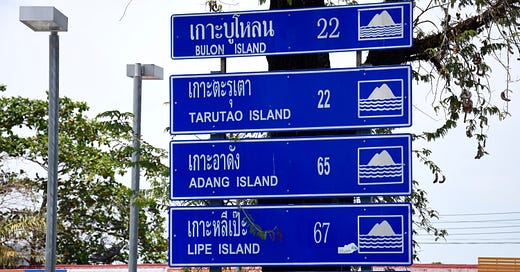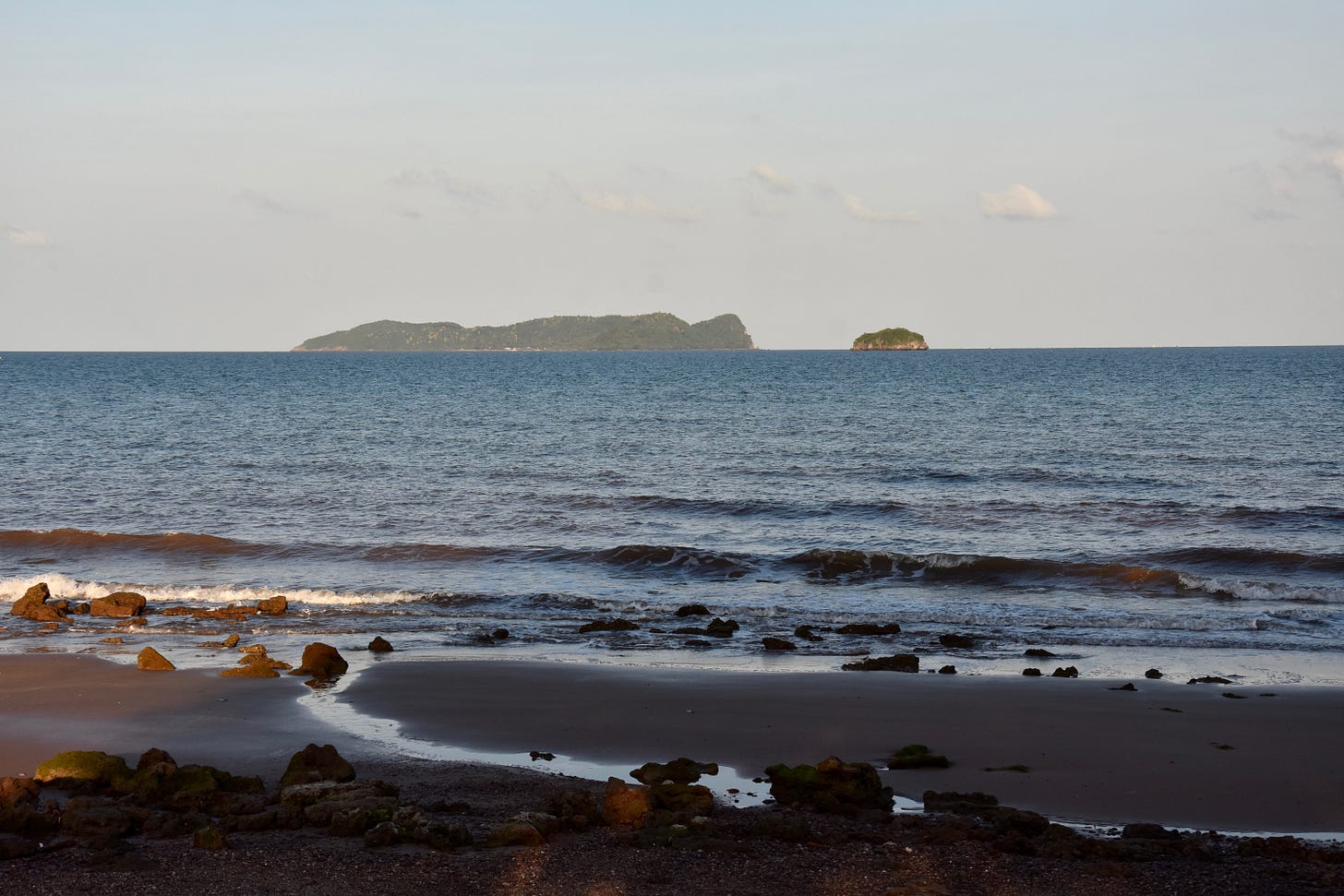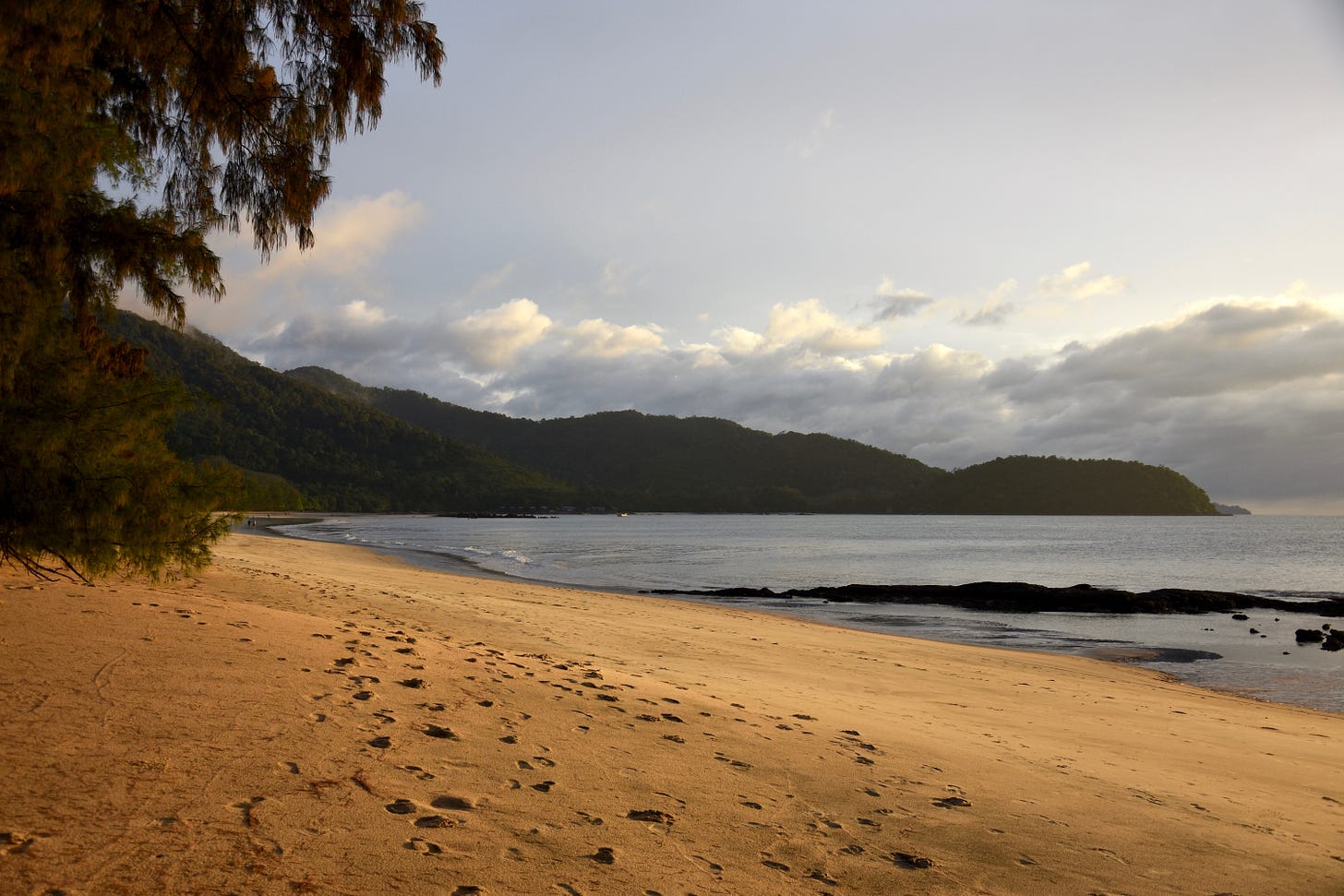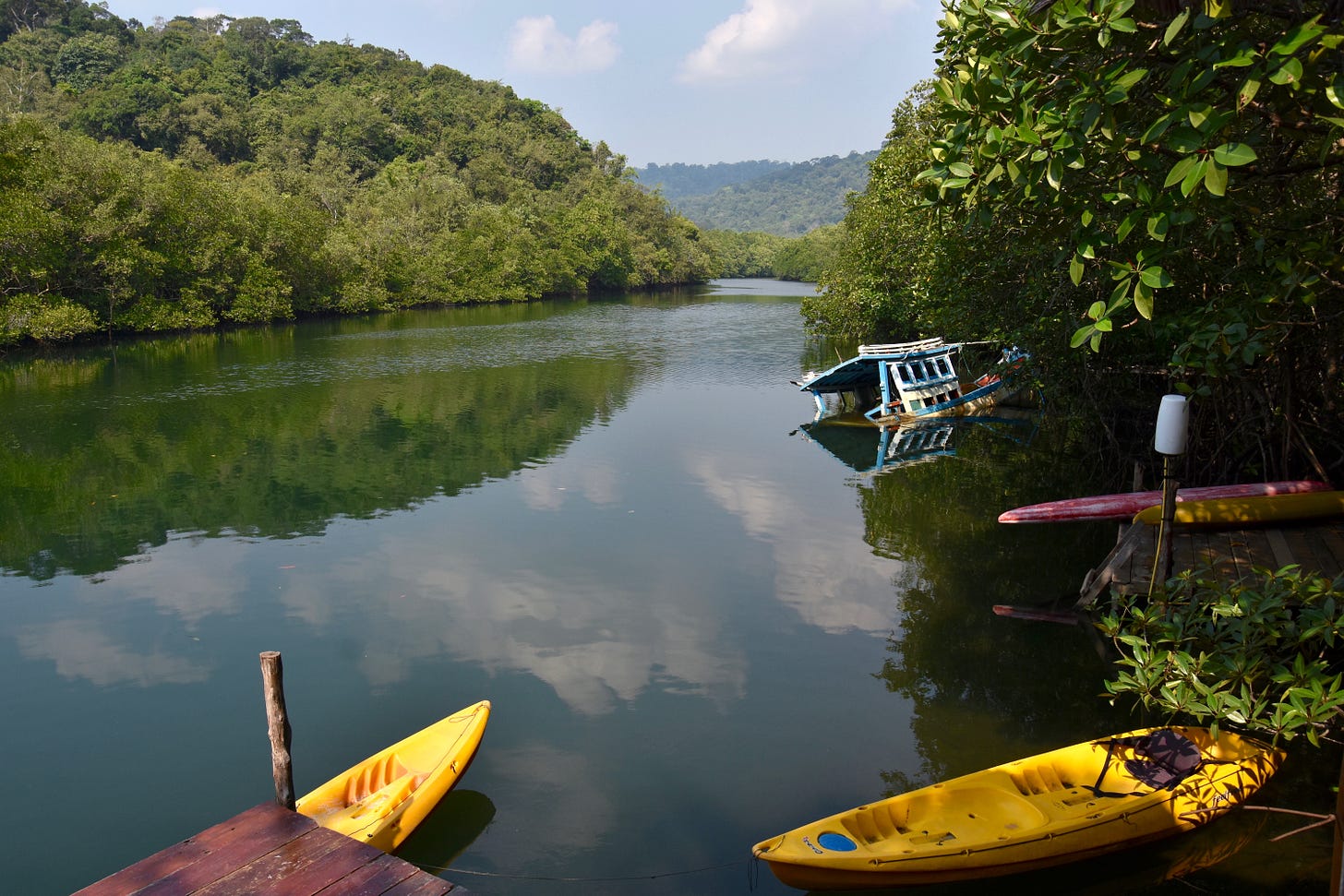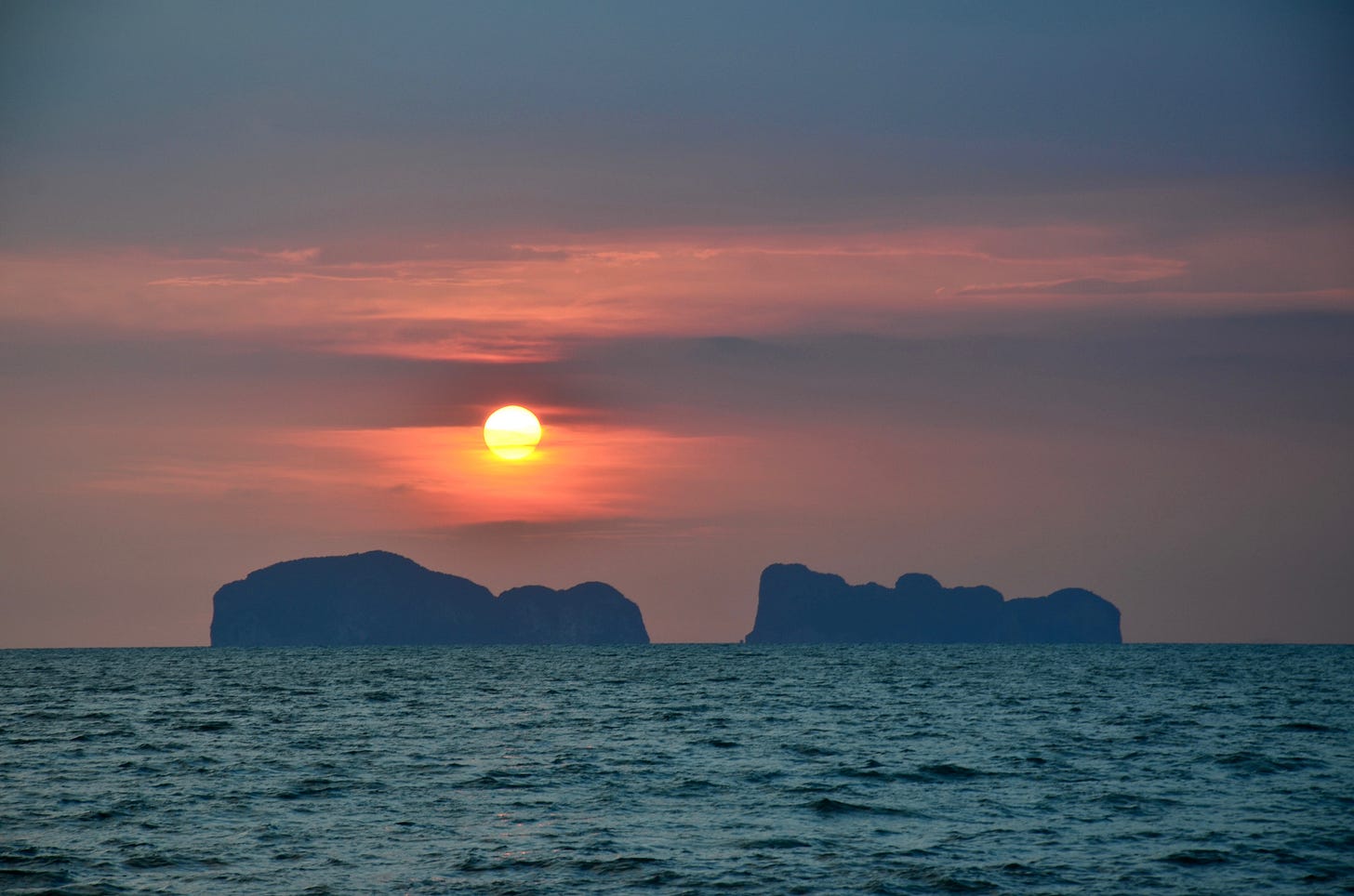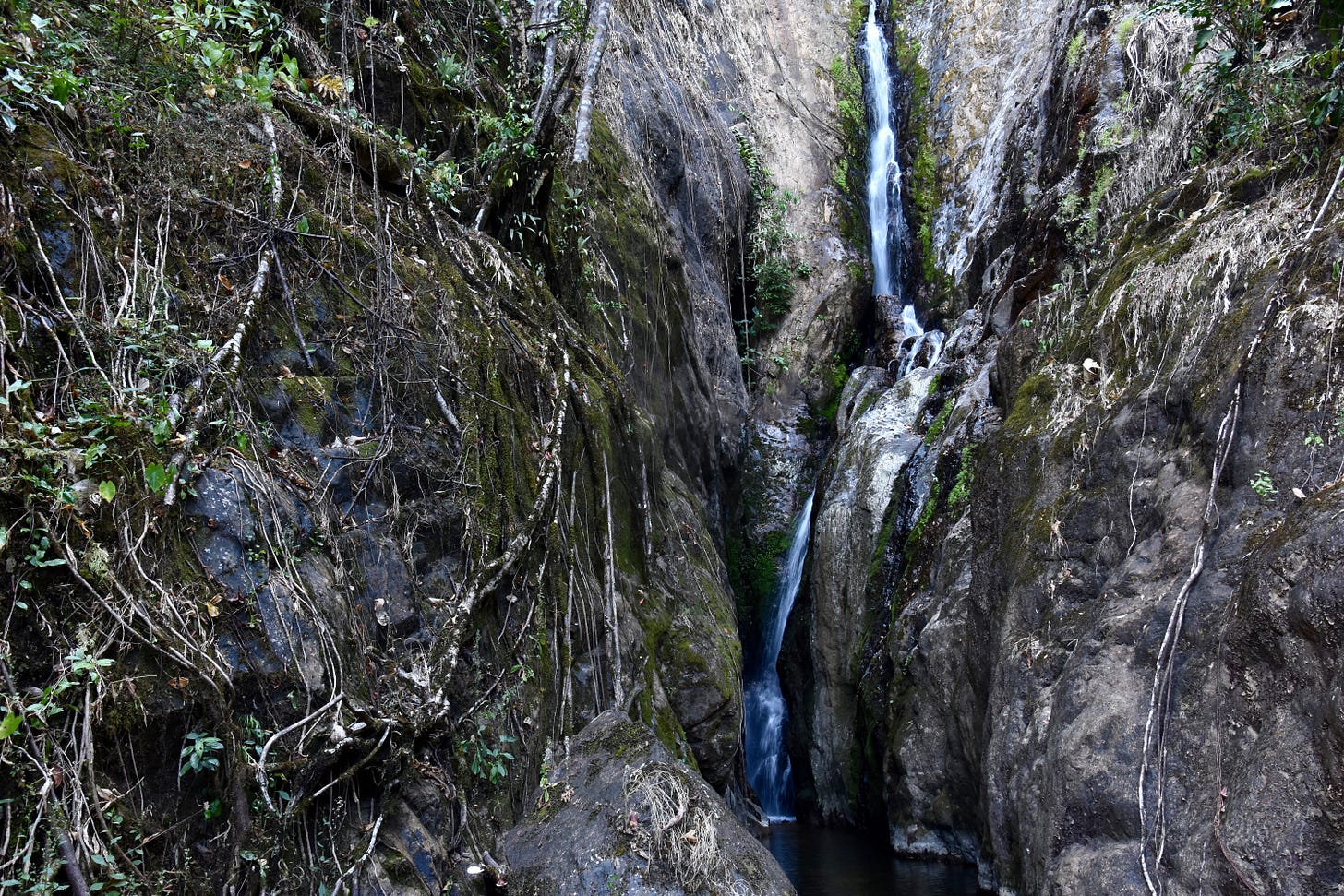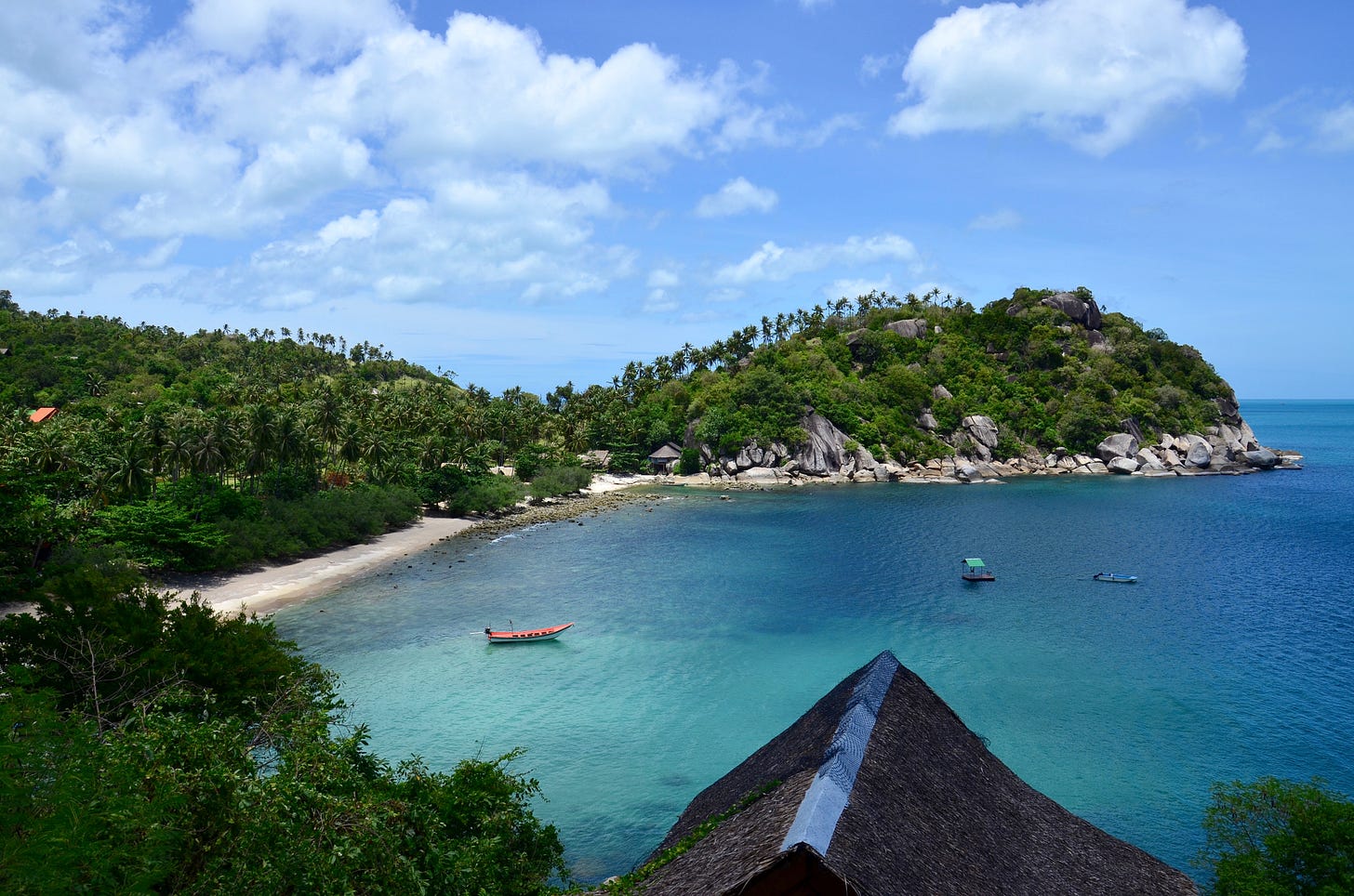Today I’m getting nerdy by explaining words, like หาด (“beach”), that you’ll see on maps and road signs in the Thai islands and coastal areas. To keep it fun for those who already know this stuff, I’ve scattered in six trivia questions on coastal Thai geography. Answers are at the end.
Admittedly, I don’t always pronounce Thai words 100% correctly. So rather than face the wrath of Thai language police by recording my own pronunciations, I’ll point you to Paiboon Publishing’s Talking Thai app for Android and iOS. It has an audio function that allows you to hear precisely how some 200,000 Thai words are pronounced. I’ve used it in tandem with other Paiboon resources for years.
(Note: Those are *not* affiliate links. Any time you see me promoting a company here in Thai Island Times, it’s because I genuinely like it.)
Thai is a tonal language in which the tone — mid, low, high, rising, or falling — changes the meaning of words. Getting the pronunciation right takes most native English speakers years of being around the language, and some of the more tone-deaf folks never get there. With that said, this article will prevent you from totally butchering words that you can’t avoid in coastal Thailand.
Foreign travelers who pronounce all five of these islands correctly get a free ferry ticket. Just kidding, but you might impress the ticket seller.
How to say “island” in Thai
The Thai word for island, เกาะ or ko (low tone), does not rhyme with the English word “go.” It’s much closer to “claw” minus the “l” and spoken with a quick pop that calls “cluck” to mind. The correct pronunciation of the first consonant, ก, falls somewhere between the “k” and “g” sounds in English. Pay attention to how both feel in the back of your throat when you say them to appreciate how close they are.
Contrary to what some terribly misguided people say, the transliteration koh is no more or less correct than ko. Both are used frequently, though I’d say koh is still the more popular of the two. I prefer ko because there is no ห, the Thai equivalent of “h,” in the word เกาะ. But in reality, both ko and koh fail miserably. As with many Thai words, Roman characters can’t even come close to เกาะ.
In Thailand, islands are called ko no matter how large or small they are. Case in point: Ko Thalu and Ko Sing in Prachuap Khiri Khan.
Trivia question #1: Let’s begin with a gentle one. Name the only one of Thailand’s 77 provinces made up entirely of islands.
Beach, bay, cape, sea, lake
The word ชายหาด or chai-hat means “beach,” though it’s typically shortened to หาด or hat (low tone). It sounds like the English “hot,” not the “hat” on your head. Haad is a better transliteration, but I use hat because that’s how it’s usually used for Thai place names like Hat Wanakon and Hat Chao Mai national parks.
แหลม or laem (rising tone) is the Thai word for “cape” or “peninsula.” The pronunciation is closer to the English “ram” than “lame.” Many Thai beaches — such as Hat Laem Sing in Chanthaburi — are named after nearby capes.
An อ่าว or ao (low tone) is a bay, large or small, that may or may not contain a beach. It sounds like “ow” as in “ow, that sea urchin hurt!” One large example is Ao Phang Nga, while Ao Maya is a well-known small bay. For beaches that are also bays, such as Ao Wong Duean on Ko Samet, hat is not added at the beginning. Ao is also used for “gulf,” as in Ao Thai or the Gulf of Thailand.
The Thai word for “sea” is ทะเล, usually transliterated as talay or thale with a high tone followed by a low tone. In Thailand, the only real example is the Talay Andaman, but the word is also used for Talay Nai, a lagoon on Ko Mae Ko in the Ang Thong islands; and Talay Noi, a marshy wetland in Phatthalung. It also appears in talay waek, which literally means “separated sea” and is often used to describe sandbars. One of the most famous of them extends between Ko Tub and Ko Gai in Krabi province.
The Thai word for a large natural “lake” is ทะเลสาบ or talay sap with a low tone for the added syllable, which rhymes with the English “pop.” Thailand has so few natural lakes that you can simply call the largest one Talay Sap and most people will know what you mean. Its full name is Talay Sap Songkhla, although it’s shared more or less equally between Songkhla and Phatthalung provinces.
On Ko Chang (Ranong), take a late-light walk an empty hat.
Trivia question #2: Two of Thailand’s capes are referred to — seemingly in error — as ko rather than laem. Can you name them?
River and canal
“River” in Thai is แม่น้ำ or mae nam. The mae (falling tone) has the same Thai vowel as laem while the nam (high tone), which means “water” on its own, rhymes with “mom.”
The nam is often dropped, however, explaining how the Mekong (or Mae Kong) River got its name. To Thai and Lao people, “Mekong River” is like saying “River Kong River.” “Kong” is spoken with a sharp rising tone, so it doesn’t sound exactly like the similar word found in the city named Hong Kong.
And don’t mix the Mekong up with the Mae Khlong, an entirely different river that flows from Kancahanaburi to Samut Songkhram in Western Thailand. Speaking of that name, smaller rivers and canals are called คลอง or khlong (mid tone) in Thai. Many Thai beaches are named after the คลอง that flow over them, such as Hat Khlong Chao on Ko Kood and Hat Khlong Mueang in Krabi.
Khlong Chao is a favorite of kayakers on Ko Kood.
Trivia question #3: Name three Thai “islands” that are surrounded entirely by river(s) and canal(s), but do not touch a sea.
Archipelago and island group
หมู่ or mu (low tone), as in “moo cow,” is the Thai word for both large archipelagos, like Mu Ko Chang, and smaller island groups, such as Mu Ko Similan.
The most common words used to differentiate twin islands are ใหญ่ or yai (low tone) and น้อย or noi (high tone). They mean “big” and “small,” with Ko Yao Yai and Ko Yao Noi being one example. An alternate word for “small,” เล็ก or lek (high tone), is used less frequently. Ko Mai Si Lek near Ko Chang (Trat), for instance.
Also common is ใน or nai (mid tone) and นอก or nok (falling tone), with กลาง or klang (mid tone) sometimes used for a third island set between the other two. These words mean “inner,” “outer,” and “central,” respectively, and a good example is the trio of Ko Man Nai, Ko Man Nok and Ko Man Klang in Rayong.
There’s also หนือ or neua (rising tone) and ใต้ or tai (falling tone), which mean “north” and “south,” differentiating Ko Surin Neua from Ko Surin Tai. In Southwest Thailand only, เลห์ or leh, which rhymes with “jay”; and ดอน or don, which sounds more like “dawn” than the name “don,” are used for islands like Ko Bulon Leh and Ko Bulon Don. A lot of the island names from down that way, like Ko Tarutao and Ko Phi Phi, derive from Malay dialects rather than Thai.
The pronouns พี่ or phi (falling tone), which sounds like “pee,” and น้อง or nong (high tone) — it rhymes with “bong” — are used to address people based on their age in Thai society. But these words also found their way into island nomenclature at Ko Lao Liang Phi, the “big sibling,” and Ko Lao Liang Nong, the “little sibling.”
Not a bad sunset over Ko Lao Liang Phi (left) and Ko Lao Liang Nong, as seen from Ko Sukorn.
Trivia question #4: Many of the geographical terms explained in this article are used at the beginning of the names of Thai national parks. But what is the term most frequently found at the front of national park names in Thailand?
Reef, cliff, waterfall and more
The Thai word for “coral” is ปะการัง or pakarang (low tone for first syllable then mid tone), while a แนวประการัง or naew pakarang is a “coral reef.” Much of Thailand’s coral lies atop the ทราย or saai (mid tone), meaning “sand.” Other reefs cloak หิน or hin (rising tone), which are large “stones” such as the Hin Daeng (“Red Rock”) and Hin Mueang (“Purple Rock”) dive sites southwest of Ko Lanta.
In the Thai Andaman, many ผา or pha (rising tone), meaning “cliffs,” tower above the sea. The word เขา or khao (rising tone) is used for mountains, such as Khao Ra on Ko Phangan, as well as hills like the monkey-occupied Khao Takiab in Hua Hin. Several น้ำตก or nam tok (high tone followed by low tone), meaning “waterfalls,” flow down from the khao of Ko Samui and Ko Chang (Trat).
ห้อง or hong (falling tone) is the Thai word for a “room” in a building, but it’s also used for “lagoons” like the one set within — you guessed it — Ko Hong. Rainy season is a good time to go rafting on แก่ง or kaeng (low tone), meaning “rapids,” in places like Khao Sok and Kaeng Krachan national parks.
Nam Tok Khlong Neung on Ko Chang (Trat) is worth the scramble over some big old boulders.
Trivia question #5: Not including the three in Phuket province, name the only seven amphoe or “districts” in Thailand made up entirely of islands.
Village, district, province
The word บ้าน or ban (falling tone), meaning “village” or “town” as well as “house,” is one of the most common words on Thai maps. It rhymes with the name “John” and not the English “ban.” While the longer baan makes more sense as a transliteration, I’ve stuck with ban because it’s most often used for place names like Ban Phe near Ko Samet. That rhymes with “Ron pays,” by the way.
Ban and บาง or bang (mid tone), which also means “town,” are part of the ตำบล or tambon (mid tone), meaning “sub-districts,” that make up Thailand’s 928 อำเภอ or amphoe (mid tone), meaning “district.” In turn, the amphoe are divided among 77 “provinces,” called จังหวัด or jangwat (mid then low tone). After a lot of research, I’ve finally learned exactly which islands belong to which provinces.
(Note: I’ve included Bangkok in the above 928 districts and 77 provinces, but technically it’s a “special administrative zone” rather than a jangwat, and its equivalents of amphoe are called khet instead.)
In Ban Phe, you will see fish.
Trivia question #6: The roughly 170 islands (depending on where you draw the borders) of Ao Phang Nga are divvied up between three different provinces. Name them.
Other pronunciation tips
The most widespread system of rendering the phonetics of Thai into Roman characters places an “h” after syllables to denote a hard sound rather than a soft one. So if you’re planning a holiday to Phuket and you’re going around telling people that you’re off to fuket, you sound like a moron. It’s poo-ket.
If you hadn’t guessed it after reading about ban, hat and laem, when you see an “a” without an “e” in transliterations of Thai, the sound is like “ahh” rather than the vowel sound found in English words like “cat.” This means that Ko Chang, Trang and, yes, the first syllable of Bangkok, do not rhyme with the English “bang.”
Another name that many foreigners butcher is Ko Phangan. The correct pronunciation is PA-NGAN, not pang-yan or pang-nan or pa-gan. I realize that “ng” can be hard to inflect in the middle of a word, but keep in mind that English speakers often say it at the end of words like “bring” and “rang.” If you can say “cling on” quickly, then you’re well on your way to pronouncing Ko Phangan correctly.
To be clear, Ko Phangan is not the same place as the province of Phang Nga. I finally learned that when, after working with a man from Phang Nga for three years back in the States, I introduced him by saying, “Tien is from Phangan, the island where they do the full moon parties.” “It’s Phang Nga!”, he insisted, before explaining the difference to myself and another bewildered American.
At Ko Phangan’s Hat Thian. Leave that “pag-yan” crap at the door.
Trivia question #7: Only five of Thailand’s 77 provincial capitals have a seafront beach set right within the city. Can you name them?
Trivia answers
Trivia answer #1: Phuket is the only one of Thailand’s 77 provinces made up entirely of islands. It includes 39 islands — such as Ko Raya Yai, Ko Maphrao, and Ko Heh — in addition to the main island, making 40 in total.
Trivia answer #2: The two Thai capes that go by ko (“island”) rather than laem (“cape”) are Ko Proet, which hosts a village on the Chanthaburi coast; and the uninhabited Ko Karot on the east side of Ao Phang Nga. Only a 50-meter-wide mangrove forest links Ko Karot to the mainland, effectively making it an island.
Trivia answer #3: Thai “islands” surrounded entirely by river(s) and canal(s) include Ko Kret within the Chao Phraya River in Nonthaburi; Ko Mueang, which contains Ayutthaya’s old quarter and is rimmed by the Chao Phraya River, the Prasak River, the Lopburi River and a canal; Ko Rattanakosin, which contains much of Bangkok’s old quarter and is rimmed by the Chao Phraya River and several canals; Bang Kachao or the “Green Lung” in Samut Prakan, which is rimmed by the Chao Phraya River and a canal; Ko Nammatha, which contains a temple within the Mae Khlong River in Ratchaburi; Ko Nok, which contains farmland within the Bang Pakong River of Chachoengsao; Rai Pan Din, which has a fishing village rimmed by the Welu River and canals in Chanthaburi; and Ko Lamphu, which has a park within the Tapi River in Surat Thani. There are many more — feel free to add in the comments.
Trivia answer #4: The most common word found at the front of Thai national park names is phu, which begins the names of 19 parks. It means “mountain” and is most often used in the Northeast. In second place with 17 parks is khao, also meaning “mountain” and used more in the Central and Southern regions. In third place with 13 parks is nam tok or “waterfall.” Then you have doi (“mountain” in the Northern dialect) with 11 parks; mae (an honorific) also with 11 parks; mu (“archipelago”) with nine parks; and khun (an honorific) with five parks. Hat (“beach”), khlong (“small river”), lam nam (“body of water”) and si (an honorific) all begin the names of four parks, while ao (“bay”) pha (“cliff”) and kaeng (“rapids”) begin three more. The names of only 35 of Thailand’s 150 national parks do not begin with one of these words.
Trivia answer #5: Not including those of Phuket province, Thailand’s only amphoe or “districts” made up entirely of islands are Amphoe Ko Chang and Amphoe Ko Kood in Trat province; Amphoe Ko Si Chang in Chonburi province; Amphoe Ko Samui and Amphoe Ko Phangan in Surat Thani province; Amphoe Ko Yao in Phang Nga province; and Amphoe Ko Lanta in Krabi province — although that last one is debatable because it includes Ko Klang, an “island” that is only separated from the actual mainland by a narrow canal.
Trivia answer #6: Phang Nga, Krabi and Phuket are the three provinces that share the islands of Ao Phang Nga. By my count, which uses a larger definition of where the bay ends than some, Phang Nga has 88 islands within the bay; Krabi has 71; and Phuket has 12. Of course, that includes the tiny specks and islets as well.
Trivia answer #7: The only provincial capitals in Thailand with a beach set right within the city are Rayong, Prachuap Khiri Khan, Songkhla, Narathiwat, and Pattani. 🌴

